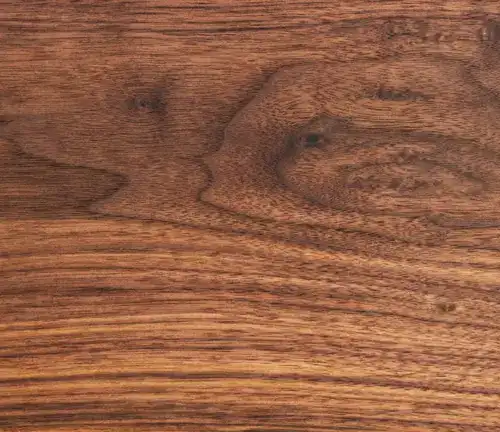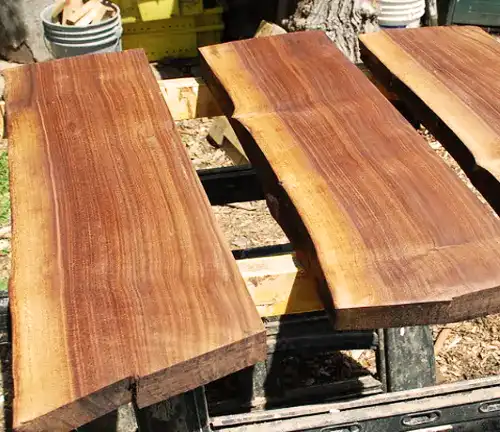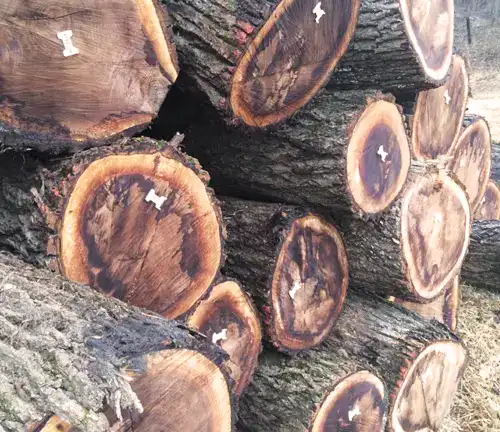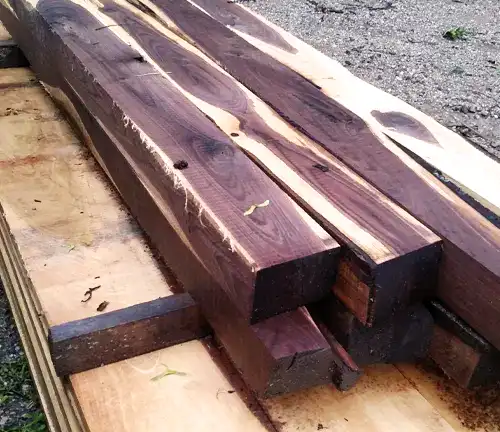Black Walnut Lumber
- June 27, 2023
- 0 comment
Black walnut lumber stands as a pinnacle in the realm of fine woods, coveted for its exquisite characteristics that elevate it to a premier choice in woodworking and furniture craftsmanship. Sourced from the heartwood of the black walnut tree (Juglans nigra), this lumber showcases a distinguished dark brown hue, often interspersed with contrasting streaks of lighter sapwood. Beyond its striking aesthetics, black walnut possesses a straight grain and a finely textured surface, embodying qualities that make it an ideal material for creating sophisticated and durable pieces.

Renowned for its resistance to decay and overall longevity, black walnut lumber is a preferred choice for crafting high-end furniture, cabinets, and flooring. Its workability is another key attribute, allowing artisans to execute precise cuts and intricate designs with ease. Moreover, the wood’s distinctive appearance adds an undeniable touch of luxury to any project, making it a favored selection among discerning craftsmen.
However, the premium quality of black walnut lumber is reflected in its cost, positioning it as a higher-priced option in comparison to other hardwoods. Despite the financial investment, the allure of its unique blend of visual appeal and performance makes it a worthwhile choice for those seeking to create enduring and aesthetically pleasing pieces.
| Property | Value |
|---|---|
| Common Name(s) | Black Walnut |
| Scientific Name | Juglans nigra |
| Distribution | North America, Europe |
| Tree Size | 70-90 ft (21-27 m) |
| Average Dried Weight | 38-43 lbs/ft3 (610-690 kg/m3) |
| Specific Gravity | 0.61-0.69 |
| Janka Hardness | 1,010 lbf (4,500 N) |
| Modulus of Rupture | 14,100 psi (97.2 MPa) |
| Elastic Modulus | 1,690,000 psi (11.64 GPa) |
| Crushing Strength | 7,580 psi (52.3 MPa) |
| Shrinkage | Radial: 5.5%, Tangential: 7.7%, Volumetric: 13.3% |
Color/Appearance

One of the defining characteristics of black walnut lumber is its stunning color. This hardwood, harvested from the heartwood of the black walnut tree (Juglans nigra), boasts a rich, deep brown hue with distinctive grain patterns. The color ranges from a medium to dark chocolate brown, often featuring swirls, curls, and waves that contribute to its visual appeal. Over time, black walnut tends to darken, enhancing its natural beauty and creating a warm, luxurious ambiance in any setting.
Grain/Texture
Black walnut is renowned for its grain and texture. The wood typically displays a straight, fine grain, but it can also exhibit irregularities such as knots and burls, adding character to the lumber. Its texture is generally medium to coarse, with a smooth, even surface that lends itself well to various woodworking applications. Woodworkers appreciate the versatility of black walnut, as it can be carved, turned, and polished to achieve intricate and highly detailed designs.

Rot Resistance

Black walnut is known for its exceptional rot resistance, making it a durable and long-lasting wood choice. Its heartwood contains natural compounds that deter decay, insects, and fungi, ensuring that projects constructed from black walnut lumber stand the test of time. This natural resistance makes it particularly suitable for outdoor applications, like furniture and decking.
Workability
Craftsmen and woodworkers prize black walnut for its ease of workability. The wood is relatively soft compared to some other hardwoods, allowing for effortless cutting, shaping, and sanding. This workability, combined with its fine grain and uniform texture, makes black walnut an ideal choice for intricate woodworking projects, including cabinetry, fine furniture, and veneers.

Odor
One distinctive aspect of black walnut is its odor. When freshly cut or machined, it emits a characteristic, rich, and pleasant aroma. This unique scent adds to the overall experience of working with black walnut and is often appreciated by woodworkers.
Allergies/Toxicity
While black walnut is generally safe to work with, some individuals may experience allergic reactions to the wood’s dust or fumes. Skin irritation and respiratory discomfort are potential concerns for those with sensitivities. Proper safety precautions, such as wearing a mask and gloves when working with black walnut, can mitigate these risks.
Pricing/Availability
The allure of black walnut comes at a price, quite literally. Its exquisite appearance, coupled with the relatively slow growth of black walnut trees, makes this lumber one of the more expensive hardwood options. Availability can also be limited in some regions due to its scarcity and high demand. However, its unique qualities make it a worthwhile investment for those seeking to create high-quality, visually striking woodworking projects.
Sustainability
Sustainability is an important consideration in the modern world of woodworking, and black walnut raises some concerns in this regard. While it’s not inherently unsustainable, the slow growth of black walnut trees means that responsible harvesting and replanting are crucial to ensure a renewable supply. Some regions have established regulations to protect black walnut stands, ensuring the long-term availability of this prized lumber.
Common Uses
Black walnut lumber’s versatility and aesthetic appeal make it a popular choice for a wide range of applications. It’s commonly used in crafting fine furniture, cabinets, gunstocks, musical instruments, and flooring. Additionally, its rot resistance makes it suitable for outdoor projects such as decks and boat building. Its luxurious appearance and timeless beauty continue to captivate woodworkers and designers, making black walnut a cherished material in the world of woodworking.


Frequently Asked Questions (FAQs)
- Why does black walnut lumber darken with age?
Black walnut lumber is known for its deep brown color, which can intensify over time. This darkening process is due to exposure to light and air, which causes the wood to undergo a natural aging and oxidation process, deepening its rich hue. Many woodworkers and furniture enthusiasts appreciate this transformation as it adds to the wood’s character and beauty. - Is it possible to sustainably harvest black walnut lumber?
Yes, sustainable harvesting practices for black walnut lumber are essential to protect this valuable hardwood species. Sustainable forestry management, which includes selective harvesting and replanting, helps ensure the continued availability of black walnut while preserving its natural habitat. - Are there any health concerns associated with working with black walnut lumber?
Black walnut wood contains natural compounds called juglone and tannins, which can cause skin and respiratory irritations in some individuals when working with it. Proper safety precautions, such as wearing protective gear and using dust collection systems, are recommended when cutting, sanding, or finishing black walnut lumber to minimize potential health risks. - Can black walnut lumber be used for outdoor projects?
While black walnut is prized for its beauty and durability, it is not the best choice for outdoor projects. It is not as naturally resistant to decay and weathering as some other hardwoods, such as teak or cedar. When used outdoors, black walnut lumber should be properly sealed and maintained to protect it from moisture and UV damage. - What are some alternatives to black walnut lumber with similar aesthetics?
If black walnut lumber is too expensive or unavailable, there are alternative wood species with similar visual characteristics. American black cherry (Prunus serotina) and sapele (Entandrophragma cylindricum) are two options often chosen for their rich color and fine grain, resembling the appearance of black walnut at a more affordable price point.







Leave your comment